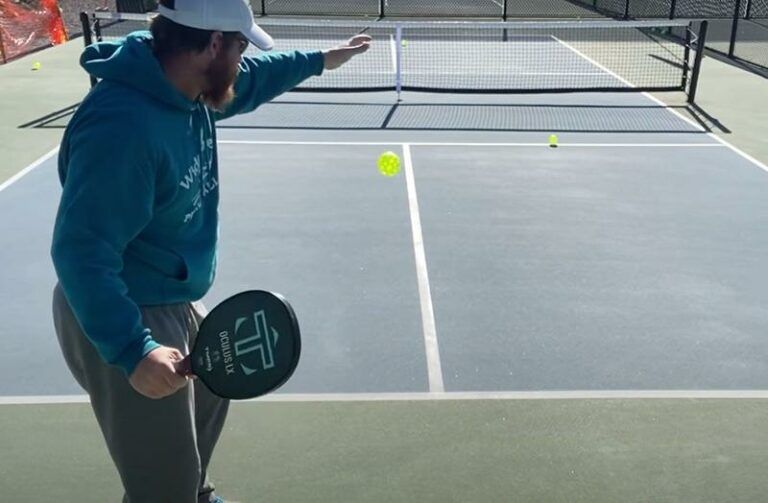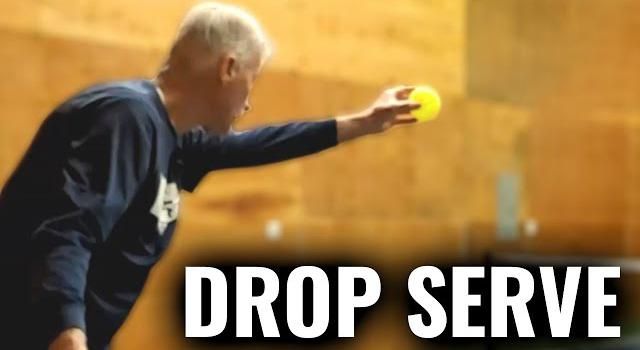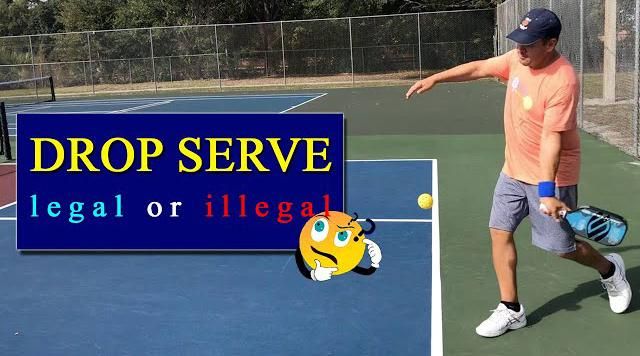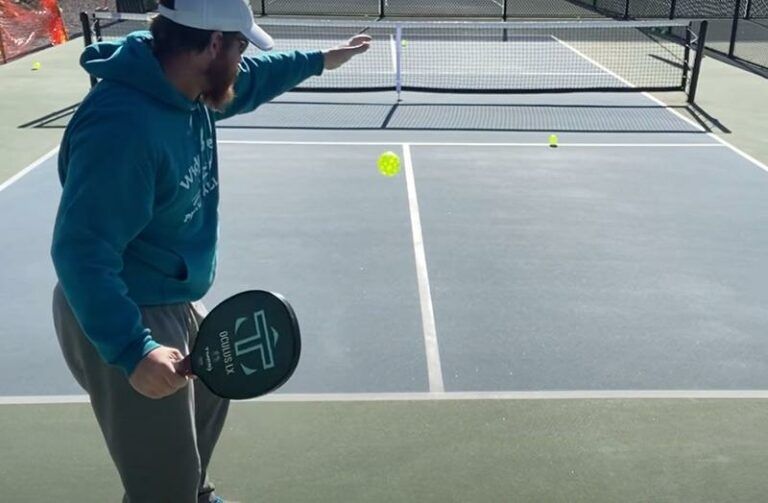Understanding the Pickleball Drop Serve
What is a pickleball drop serve?
At its core, the pickleball drop serve presents a unique contrast to the traditional volley serve. Instead of hitting the ball while it's airborne, players drop the ball onto the court before making their strike. Historically aimed at supporting players with disabilities, this method has gained traction among all players, simplifying the serving process and making it more accessible. The legality of this technique for all players highlights pickleball's commitment to inclusivity and adaptability, ensuring everyone can participate regardless of their background or physical ability.

The transformation of the drop serve from an experimental concept to an established rule showcases the sport's agility in meeting the needs of its community. With no specific height requirement on the release, players can drop the ball from various heights, adding a personal touch to their serving style. Moreover, the bounce requirement where the ball must hit the court before the player strikes it encourages a more fluid and less rushed serving technique, allowing for greater precision and control.
In this new era of pickleball, the drop serve serves as a stepping stone for beginners. By providing unequivocal clarity in motion and technique, it eases the learning curve typically associated with the game. Players can focus on honing their skills without the pressure that often accompanies the volley serve, making this technique a valuable tool in the aspiring pickleball player's arsenal.
Why learn the drop serve?
The drop serve offers an enticing entry point into the world of pickleball, especially for those who may not have a background in racket sports. Its ease of learning makes it particularly appealing to beginners, as it helps them develop essential skills while minimizing the stress often felt during traditional serving. The predictability of the drop serve allows players to cultivate consistency, enhancing their overall game.
One of the standout advantages of the drop serve is its ability to reduce pressure. For many beginners, the volley serve can generate anxiety due to its reliance on precise timing and placement. By contrast, the drop serve allows players to take their time and focus on technique, enhancing their confidence and encouraging experimentation with their style. As they become more comfortable, players can gradually introduce complexity into their game, building a solid foundation for future advancements.

With growing popularity, the drop serve has become a hallmark of modern pickleball strategy. By embracing this technique, beginners can easily transition into intermediate levels, increasing their skill set while enjoying their time on the court. Ultimately, mastering the drop serve allows players to feel empowered, fostering a positive and enjoyable learning experience.
Mastering the Drop Serve Rules
Key rules for a legal drop serve
Understanding the rules governing the drop serve is crucial to executing this technique effectively and legally. Here’s a breakdown of the essential rules to keep in mind:
- Natural Release: The ball must be dropped from one hand only or off the paddle face from a natural height without any excessive force.
- Bounce Requirement: The ball must bounce on the court before a player strikes it, ensuring no errors in executing the serve.
- Visible Motion: The motion must be clear and visible to both the receiver and the referee if present, promoting fairness and transparency.
- Contact Position: The player must strike the ball at or below their waist level after it has bounced.
- Stance: Players must have both feet behind the service line and ensure that at least one foot remains on the ground until the ball is hit.
Emphasizing these rules highlights the unique differences between the drop serve and the traditional volley serve. Unlike the volley serve, which has more restrictions regarding paddle height and contact point, the drop serve allows for greater flexibility and creativity, providing players a new avenue to explore their serving techniques.

Common drop serve faults to avoid
Despite its simplicity, beginners can still encounter common pitfalls when executing the drop serve. It's essential to be aware of these faults to prevent giving the opponent an unnecessary advantage:
- Excessive Drop Height: Dropping the ball from too high can result in an illegal serve; players should always release from a manageable height.
- Added Force or Spin: Propelling the ball down with significant force or imparting spin before it bounces violates the technique's fundamental principles.
- Improper Foot Positioning: Failing to keep feet behind the baseline can lead to penalties, undermining the serve's legality.
- Forgetting the Bounce: Not allowing the ball to bounce before making contact renders the serve invalid.
Understanding the consequences of these mistakes is vital. When a fault occurs, the opponent earns a point, disrupting the flow of the game and affecting overall performance. By staying vigilant and adhering to the established rules, players can execute successful drop serves with confidence and precision.
Step-by-Step Guide to the Perfect Drop Serve
Grip and stance
The first vital step in mastering the drop serve lies in establishing the proper grip and stance. An optimal grip ensures control and precision when making contact with the ball. For beginners, using a handshake grip where the paddle feels like an extension of your arm could be the most intuitive choice. This grip allows for a natural swing and easy adjustments.
When it comes to stance, players should adopt a sideways position with their feet angled towards the intended target. This position not only aids in generating power but also promotes balanced movements during the swing, ensuring weight shifts appropriately from back to front. With feet firmly planted and legs slightly bent, players should feel grounded yet ready to spring into action.
Dropping the ball
Once the grip and stance are established, the next step involves the dropping technique. It’s crucial for players to practice dropping the ball from a natural height typically between shoulder and waist height using one hand or allowing it to roll off the paddle face. The drop must occur unassisted by pushing or propelling it downward; players should rely on gravity alone.
By focusing on the drop, players can cultivate a rhythm that complements their overall serving strategy. This moment of gravity not only builds anticipation but also contributes to the fundamental bounce required before making contact. Practicing this step will ensure consistency in serving and allow players to strike at the optimal point after the bounce.
Timing the bounce and making contact
As players develop their skills, mastering timing becomes crucial. The key lies in waiting for the ball to peak after the bounce before swinging with the paddle. Striking too early can lead to mishits, while waiting for the perfect moment fosters better accuracy and control during the swing.
Proper swing mechanics involve a smooth upward motion that ensures a clean hit at or below the waist. Beginners should focus on creating a fluidity in their movements that feels natural and instinctive, almost reminiscent of a dancer gracefully executing a choreographed routine. This balance between control and power will enhance their overall performance while executing the drop serve.
Follow through for accuracy
The importance of a complete follow-through after hitting the ball cannot be overstated. A well-executed follow-through promotes accuracy and control over where the ball ultimately lands. Players should extend the paddle towards their target, making sure the motion feels intentional and fluid.
In emphasizing this step, players can assure they’re not merely striking the ball but engaging in a comprehensive process that involves aim, momentum, and precision. This follow-through not only embodies the conclusion of a successful serve but reinforces the significance of technique in ensuring the ball reaches the desired area of the court.
Benefits of the Drop Serve for Beginners

For new players entering the pickleball realm, the drop serve’s learning curve is noticeably gentler compared to the traditional volley serve. Several elements contribute to this simplicity:
- Increased Reaction Time: The ball's bounce allows players more time to react and prepare for their swing, easing any initial nervousness.
- Simpler Swing Mechanics: The mechanics involved in the drop serve eliminate the need for high-impact swings or precise positioning, making it easier to grasp.
- Less Focus on Timing: The absence of a required hit in mid-air alleviates pressure, allowing beginners to focus on developing a consistent technique without added complications.
These factors intertwine to create a supportive environment in which beginners can flourish. By mastering the drop serve, players can gain fundamental skills that will bolster their confidence and competence on the court.
Develop consistent timing and rhythm
Mastering the drop serve also plays a substantial role in establishing consistency and rhythm. The predictable nature of the bounce allows players to anticipate the ball's trajectory, leading to improved timing and synchronization during their swing. As they practice, players will notice that they can better predict when to initiate their swing, reducing mishits and errors over time.
Regular practice of the drop serve can lead to an evolved sense of rhythm. When players find their groove with the drop serve, it becomes almost second nature. This newly developed timing fosters confidence, paving the way for further skill development and the ability to switch between different serving techniques seamlessly.
Reduce pressure and gain confidence
Embracing the drop serve can also significantly alleviate pressure and instill a sense of confidence in beginner players. Many individuals experience anxiety related to serving, particularly when they feel scrutinized or stressed during games. The drop serve mitigates this intimidation factor by allowing players to focus on their movements without the urgency of hitting a moving target.
This pressure-free environment encourages players to concentrate on executing their technique instead of worrying about making errors. As players become more comfortable with this serve, their overall enjoyment of the game will increase, ultimately stimulating further engagement and practice.
The "Soft Drop Serve": A Secret Weapon for Beginners
What is a soft drop serve?
The soft drop serve presents itself as a strategic variation of the standard drop serve. Rather than powering the ball deep into the court, players aim to place it short and low in their opponent's service area. This subtle alteration in strategy disrupts the opponent's rhythm and often compels them to return the serve with more force or less accuracy.
Utilizing the soft drop serve challenges opponents, forcing them to adjust their positioning. By taking them off guard, players can create opportunities to capitalize on weak returns. As a result, mastering the soft drop serve can become an essential aspect of a beginner’s repertoire, blending seamlessly into an evolving gameplay strategy that accentuates adaptability and creativity.
Advantages of the soft drop serve for beginners
There are several significant advantages of the soft drop serve specifically tailored for beginner players. Among them are:
- Enhanced Control: The soft drop serve allows players to develop their placement skills, focusing on accuracy rather than power. This helps cultivate a more refined serving technique.
- Disruption of Opponent's Rhythm: By mixing in soft drop serves, players can limit their opponent's momentum and control over the game. This unpredictability makes it more challenging for opponents to settle into their usual patterns.
- Confidence Building: Successfully executing a soft drop serve contributes to a player’s confidence. As they see positive results from their placements, they will be encouraged to experiment further and gain a deeper understanding of their strengths.
Embracing this serve creates opportunities for beginners to explore different strategies and evolve as they progress through different levels of play.
Executing the soft drop serve
Executing the soft drop serve involves a few significant adjustments in technique:
- Adjusting Swing Path: Players should alter their swing path to achieve a shorter, softer contact with the ball, ensuring control over the ball's speed and trajectory.
- Delicate Touch: Developing a more delicate touch with the paddle will be crucial in the execution of the soft drop serve. Practicing this can lead to a tight-knit connection between the player and the ball, resulting in a more controlled serve.
- Targeting Specific Landing Zones: Aiming for specific locations near the net enhances strategic depth while forcing opponents into uncomfortable positions.
By focusing on these adjustments, players can transition seamlessly between traditional and soft drop serves, enriching their gameplay and upping their competitive edge.
Practicing the Drop Serve: Drills for Success
Consistency drills
To master the drop serve, beginners should engage in practice drills that foster consistency and repetition. Here are some suggested drills:
- Target Zone Dropping: Set up specific areas on the court where you want the ball to drop, practicing the technique of letting the ball bounce into those zones repeatedly.
- The Drop and Swing Drill: Without hitting the ball initially, practice the drop motion followed by a simulated swing. This exercise helps refine technique and muscle memory.
- Controlled Bounce Practice: Establish a routine where you practice dropping the ball without adding unnecessary force or spin. This drill nurtures the fundamental principles behind the drop serve.
These drills not only hone the technical aspects of the drop serve but also contribute to building confidence on the court.
Placement drills
Targeting specific landing zones is a beneficial practice for beginners looking to develop control and precision. Consider these drills:
- Zone Targeting: Create marked areas on the court and practice serving to those spots, gradually increasing the difficulty as you become more confident.
- Partner Placement Drill: Work with a partner to practice targeted drop serves back and forth, allowing for constructive feedback and a focus on accuracy.
These activities reinforce the importance of aim and allow players to become more aware of their surroundings during gameplay.
Timing drills
Incorporating timing drills into practice sessions can help players enhance their rhythm and adaptability in live scenarios. Suggested drills include:
- The 10-Second Rule Drill: Players have ten seconds to execute the drop serve immediately after each point. This practice conditions them to respond quickly and maintain focus.
- Game Simulation Pressure Practice: Mimic real-game scenarios with a partner, allowing for competitive pressure and testing consistency in executing the drop serve under duress.
These exercises fortify mental readiness, encouraging players to adapt their skills dynamically while maintaining a fresh and engaging practice environment.
Drop Serve vs. Volley Serve: Which Is Right for You?
Pros and cons of each serve for beginners
When evaluating the drop serve and the traditional volley serve, beginners should relish in exploring the pros and cons of each to determine which resonates best with their playing style:
| Service Type | Pros | Cons |
|---|---|---|
| Drop Serve | - Easier to learn - Less pressure on timing - More predictable | - Limited power potential - Less spin options |
| Volley Serve | - Greater power potential - More deceptive | - Higher learning curve - Requires precise timing |
By weighing these factors, beginners can make informed decisions about which serve to focus on as they develop their skills, ultimately contributing to their overall enjoyment of the game.
Choosing the right serve for your skill level
In deciding between serves, players should conduct a self-assessment of their current skill level. Assessing personal comfort levels when practicing will dictate which serve may be more advantageous at any given moment. Additionally, as players progress, blending both serving techniques into their playbook can lead to a more dynamic and unpredictable style, making further advancements seamless in future matches.
Elevate Your Serving Game: Beyond the Basics
Progressing to the Volley Serve
As players become adept at executing the drop serve, transitioning to the volley serve becomes an inevitable next step. This progression is crucial for maximizing offensive capabilities within the game. With established confidence in the drop serve, players will find the mechanics of the volley serve more approachable. Continued practice and commitment will facilitate an expanded skill set.
The importance of continuous practice
Mastering the drop serve and volley serve requires dedication to practice. Consistent repetition fosters improvement, effectively embedding skills into muscle memory. Engaging in diverse drills and exercises ensures that players can maintain and enhance their performance levels. As the old saying goes, "practice makes perfect," and cultivating this mindset allows players to strive toward excellence in their gameplay.
Serving as a foundation for success
An effective serving strategy sets the stage for success during matches. Your service can dictate the tempo and flow of the game, allowing players to establish an offensive presence right from the start. Thus, embedding the drop serve and volley serve into your skill set not only transforms your individual gameplay but also contributes significantly to overall team performance and success.
In conclusion, the pickleball drop serve serves as an invaluable tool for beginners venturing into this dynamic sport. As players hone their skills through practice and dedication, they can embrace a variety of serving techniques, making their games uniquely their own. Embracing these fundamentals fosters enjoyment and confidence on the court, leading to a fulfilling pickleball experience for all who participate.










